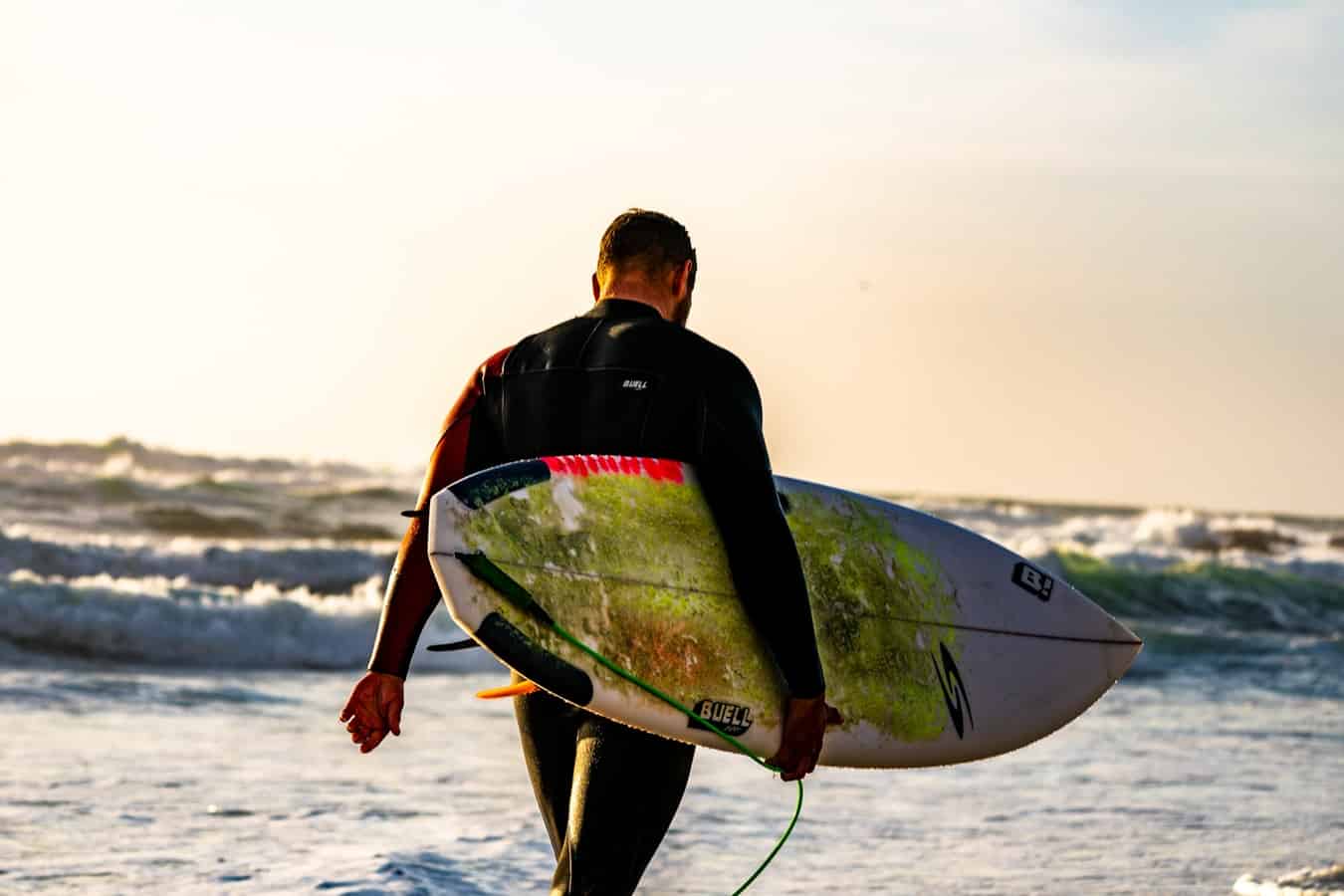We already know that surfing is one of the best sports out there. Sitting out on the water, riding a wave, there’s nothing quite like time at the beach and in the ocean. It’s no wonder so many people out there are finding the sport everyday.
But surfers tend to have a stereotypical physical appearance, and I’m not talking about haircuts or clothes. Surfing builds muscle groups specific to its activity. One you may have noticed, surfer’s rock big necks.
Surfers tend to have big necks for two reasons. First, they spend a lot of time in the prone position (belly down) with the head raised. This position causes the muscles on the back of the neck to engage, causing greater strength over time. Secondly, surfing requires strong use of the deltoids, latissimus dorsi and most importantly, the trapezius. This combination of muscles play a major role in the bulking of the neck.
The deltoids, latissimus dorsi, and trapezius are all part of the shoulder muscle group. They’re used in reaching, pulling and rotating your arms. Exactly the definition of necessary movement when it comes to paddling.
Paddling is all about this muscle group. The whole process of getting out into the waves requires use of not just these three main muscles, but the shoulder group as a whole.
That means, the more time you spend surfing, the stronger and bigger these muscles get.
On top of the shoulder muscles, the splenius capitis and splenius cervicis, or the muscles on the back of your neck, are also required while paddling. In order to lift the head, these two muscles must be engaged, so they play a huge role while navigating the waves.
The neck is also integral when it comes to balance. The neck acts like a stabilizer to the rest of the spine. When the neck has the strength to stay in place, it sets the stage for the core and other stabilizing muscles to do their job.
It’s hard to stay standing on the water if your neck is moving around. Thus, these neck muscles are built when riding a wave.The combination of all these, leads surfers to have thicker necks.
Benefits of a strong neck
The neck is often one of the most neglected muscle groups out there. Everyone wants great abs or arms, but how often do you hear someone mention needing to train their neck?
In this regard, surfers are ahead of the game because there are plenty of reasons for a strong neck.
Protection from Injury
By building up the neck muscles you’re protecting yourself from possible injury. Not only when lifting and reaching for heavy things, but from impact, such as wiping out. A vital benefit for any surfer.
The neck works like a shock absorber, bracing when there’s impact. The stronger your neck is the better it can absorb this impact. Which in turn, can greatly reduce your risk of concussion.
Strengthening the neck muscles can also prevent Surfer’s Neck, a common condition where the muscles in the back of the neck cause pain to the neck and shoulders. Working out and stretching these muscles regularly gives you a leg up in preventing Surfer’s Neck.

Better Performance
As we’ve discussed, a big neck is a side effect of the muscles used in surfing. But this strong neck also helps performance. Having well developed neck muscles actually helps you breathe better.
The respiratory system uses muscles in your neck to work properly, especially when doing a strenuous activity. While you’re vigorously paddling, a strong neck is actually helping your endurance.
So, a strong neck can help you to have longer sessions.
A strong neck also helps the nerve impulses running from your brain through your spine work properly. These nerve impulses contribute to balance and movement. Two key elements of surfing.
By strengthening the neck muscles, you are helping to improve your balance and stability.
Better Posture
So often we don’t even realize we have poor posture. Sitting at a desk all day, sleeping in a weird position or just slouching in general are all common causes of poor standing posture.
But, did you know bad posture takes a physical toll on the body? It can lead to an array of issues, like headaches, back and neck pain, even fatigue and trouble breathing. A strong neck helps relieve these potential problems. The head and neck set the stage for the rest of the spine below it.
When the muscles that contribute to the neck are strong and healthy, it becomes easier to stand up straight and maintain better posture.
Exercises for a Strong Neck
Although surfing helps in building a strong neck, it’s also important to train these muscles out of the water as well. This can go a long way in preventing possible injury, including Surfer’s Neck.
Outside training is like insurance for the necessary muscles to improve and maintain performance. So how the heck do you exercise your neck?
Shoulder Shrugs
- Start in a standing position, feet hip width apart
- Place one dumbbell in each hand, palms facing inward, shoulders back. Dumbbells should be heavy enough to slightly pull the shoulders down
- Slowly lift shoulders towards the ear without rolling them forward
- At the top of the movement, hold for a count of 2
- Slowly lower back to starting position
- Repeat until set is complete
Neck Flexion
- Start in a standing position, feet hip width apart
- Place an exercise band around the forehead
- With the hands placed behind the back, hold the band in place
- Slowly lower the head towards the chest as far as it will go
- Once chin reaches chest, or as far as it will go, hold for a count of 2
- Slowly lift the head to starting position
- Repeat until set is complete
Neck Extension
- Start in a standing position, feet hip width apart
- Place exercise band around the back of the head, in line with the occipital bone
- With the hands together at chest level, hold the band in place
- Slowly reach the head backward as far as you can go without pain
- Hold for a count of 2
- Slowly move head forward to starting position
- Repeat until set is complete
Lateral Extension
- Start in a standing position, feet hip width apart
- Place exercise band around the left side of the head, in line with the forehead
- With the right hand held at shoulder level on the right side, hold the band in place
- With shoulders back and lowered, eyes facing forward, slowly move the left ear towards the left shoulder
- Once you have reached as far as you can go comfortably, hold for a count of 2
- Slowly raise the head back to starting position
- Repeat until set is complete
It’s important to note, safety and position are very important during neck exercises. The neck is one of the most important parts of the body and made up of very small muscles.
Take care to move through exercises with slow and controlled movements, maintaining proper form. If you experience pain, stop immediately.

Stretches For Surfer’s Necks
As important as exercise to strengthen the neck muscles are, exercise to stretch the neck muscles are just as important if not more.
Tight neck muscles lead to pain. This pain can start in the neck then spread to the back and hips if not managed properly. Not to mention, tight neck muscles are a common cause of headaches as well. Luckily, stretching helps prevent these problems. Here are four great ways to stretch out your neck.
Forward Tilt
- Start in a standing or seated position, shoulders back, neck in straight line with the spine
- Slowly lower forehead down, guiding chin towards chest
- Once chin reaches chest or as far as it will go, hold position for a count of 8
- Slowly raise head to the starting position
- Repeat as needed
Back Tilt
- Start in a standing or seated position, shoulders back, neck in straight line with the spine
- Slowly lean head backward, guiding chin towards the ceiling
- At the top of your range of motion, hold position for a count of 8
- Slowly lower the head back to starting position
- Repeat as needed
Side Tilt
- Start in a standing or seated position, shoulders back and down, neck in straight line with the spine
- Slowly lower left ear toward left shoulder, maintaining alignment with the rest of body
- At the top of your range of motion, hold position for a count of 8
- Slowly raise head back to starting position
- Repeat on right hand side for one set
- Repeat full exercise as needed
Side Rotation
- Start in a standing or seated position, shoulders back, neck in straight line with the spine
- Slowly turn head towards your left hand side, maintaining your upright alignment
- At full extension, hold for a count of 8
- Slowly return to the starting position
- Repeat on right hand side for one set
- Repeat full exercise as needed
Again, it’s important to reiterate slow and pain free movement when stretching or exercising the neck. These stretches should feel good. If you experience pain, shorten your range of motion.
Related questions
Does Surfing Hurt Your Neck From Surfing?
Surfing is a full body experience that requires great strength and stability, not just from the neck but the whole body. Paddling and wiping out have the potential to cause neck pain, which is why strengthening the neck is such an important factor.
What Muscles Do Surfing Build?
While surfing works out the whole body, you might wonder specifically what muscles. Surfing builds all the major muscle groups from top to bottom.
We’ve gone over the neck and shoulders, but it also builds the biceps, triceps and chest during paddling and popping up. The core, including the obliques are engaged during popping up and balancing on a wave. These moves also work the glutes and thighs.
If you’re looking for a fun and interesting way to build muscle, surfing is a great option.
Is Surfing Good For You?
Despite the potential risks for injury, surfing is a great activity. Surfing is a fun sport that has the ability to combine both mental and physical bonuses. Being in the water and in nature have proven benefits to our emotional and mental wellbeing.
On top of this added plus, surfing is both an aerobic and strength training sport. It requires great aerobic capacity and great muscle strength to perform. All in all, surfing isn’t just good for you, it’s great for you.

